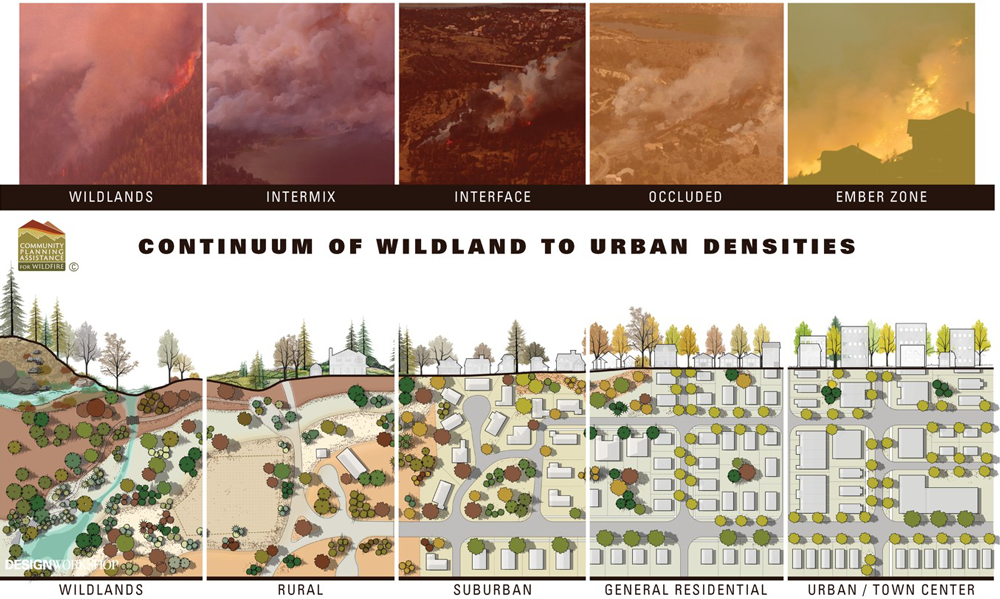Managing Shared Urban-Wild Spaces
With growing urbanization and agricultural development, habitats are being disturbed. Loss of habitat forces species into smaller spaces. There is an increase in competition, crowding occurs, and increase in disease outbreaks. The Equilibrium Theory explains that if there is an increase in the amount of species in one area, the higher rate of species extinction increase. This leads us to believe that there are many challenges that need to be thought of while development continues. One major concern in the wildland-urban interface is wildfires and the dangers in firefighting. Another major concern is the "edge effects" that are created by the boundaries of roads.
The close border zone between housing and the wilderness increases many risks if there is a potential wildfire. When wildfires encounter homes and large communities, they are also encountering hazardous materials, utility and gas lines, and many common chemicals. This can lead to explosions or toxic fumes being released into the air if a wildfire were to encounter these communities. If a wildfire were to break out, the best thing to do is to try and prevent spread of the fire immediately. If it gets too dangerous, it's important to evacuate the area
Some common effects that are caused by roads going through habitats include: increased wind disturbance, higher temperatures, lower humidity, and higher rate or dead animals. Other effects specifically seen in Wisconsin is nutrient and salt pollution, soil erosion, and increase in invasive species. When building roads, it's important to take into account the habitat that is being taken away and how it will affect different species. Wildlife crossings over highways might be a great addition to ensure that animals are able to cross roads safely. Another important thing to do in order to reduce pollution in nearby soil is to clean roads often, especially after the winter months. This will help clean the salt off the roads so less gets to the soil.
In order for humans to live in harmony with the wilderness, it is important to learn about the steps that you can take to prevent any harm. For example, one popular outdoor recreation in Wisconsin is fishing. Boat owners should be careful when moving from lake to lake and ensure they are not introducing new species to a different body of water. This can have detrimental effects on the entire ecosystem of a lake. It's also important to reduce the amount of pollution that might occur during these recreational activities. This will make sure that the habits stay in tact for the ecosystem it is supporting.
https://www.firerescue1.com/fire-products/wildland-fire-products/articles/wildland-urban-interface-hazards-RnKvX3yVq8S3F2ae/#:~:text=Firefighters%20in%20the%20wildland%20urban,utility%20lines%20and%20poor%20access.&text=Common%20chemicals%20used%20around%20the,or%20vapors%20or%20off%2Dgassing.
https://education.nationalgeographic.org/resource/wildlife-crossings/
https://www.google.com/url?sa=i&url=https%3A%2F%2Fwww.redwoodcity.org%2Fdepartments%2Ffire-department%2Ffire-prevention%2Fdefensible-space%2Fcalifornia-wildland-urban-interface-code-information&psig=AOvVaw1d3nI9QMBrkyf9qSYU3FLU&ust=1685998161270000&source=images&cd=vfe&ved=0CBIQjhxqFwoTCMCt392-qv8CFQAAAAAdAAAAABAE

I liked your idea of having a safe wildlife crossings over highways, however, I'm not exactly sure how we would need to go about it. I know there are currently signs here and there that make drivers pay attention to the possible wild animals crossings, but it still does not prevent car crashes with animals and we often see dead deers or raccoons on the road. Other than that, I also liked how you made the point of cleaning the roads often. There is so much pollution that is just building up over the year, so we definitely could do a better job to make sure we keep it under control as much as we can.
ReplyDeleteI completely forgot to mention the issue of the decrease in biodiversity due to deaths due to cars. I like the idea of wildlife crossings, although it does seem to be difficult idea to put into action. How could we guarantee that animals would know to use these crossings? The simple solution is to avoid cutting through these habitats but that is unlikely, I liked your creative solutions, but I believe the most important thing is the respect these ecosystems and focus on doing our best not to interfere these areas in a dangerous way.
ReplyDelete